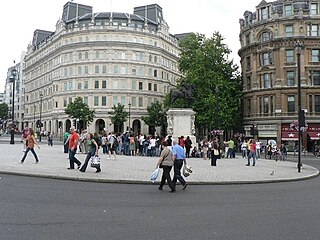
Charing Cross is a junction in Westminster, London, England, where six routes meet. Since the early 19th century, Charing Cross has been the notional "centre of London" and became the point from which distances from London are measured. Clockwise from north, the routes that meet at Charing Cross are: the east side of Trafalgar Square leading to St Martin's Place and then Charing Cross Road; the Strand leading to the City; Northumberland Avenue leading to the Thames Embankment; Whitehall leading to Parliament Square; The Mall leading to Admiralty Arch and Buckingham Palace; and two short roads leading to Pall Mall.

Trafalgar Square is a public square in the City of Westminster, Central London, established in the early 19th century around the area formerly known as Charing Cross. The square's name commemorates the Battle of Trafalgar, the British naval victory in the Napoleonic Wars over France and Spain that took place on 21 October 1805 off the coast of Cape Trafalgar.

The West End of London is a district of Central London, London, England, west of the City of London and north of the River Thames, in which many of the city's major tourist attractions, shops, businesses, government buildings and entertainment venues, including West End theatres, are concentrated.

The Metropolitan Police Service (MPS), formerly known as the Metropolitan Police, which is still its common name, serves as the territorial police force responsible for law enforcement and crime prevention within Greater London. In addition, it is responsible for specialised tasks throughout the United Kingdom, such as dealing with counter-terrorism throughout the UK, and the protection of certain individuals, including the monarch, royal family, governmental officials, and other designated figures. Commonly referred to as the Met, it is also referred to as Scotland Yard or the Yard, after the location of its original headquarters in Great Scotland Yard, Whitehall in the 19th century. The Met is presently headquartered at New Scotland Yard, on the Victoria Embankment.

Haymarket is a street in the St James's area of the City of Westminster, London. It runs from Piccadilly Circus in the north to Pall Mall at the southern end. Located on the street are the Theatre Royal, His Majesty's Theatre, New Zealand House, a cinema complex and restaurants.

Bloody Sunday was an event which took place in London, England on 13 November 1887, when a crowd of marchers protesting about unemployment and the Irish Coercion Acts, as well as demanding the release of MP William O'Brien, clashed with the Metropolitan Police. The demonstration was organised by the Social Democratic Federation and the Irish National League. Violent clashes took place between the police and demonstrators, many "armed with iron bars, knives, pokers and gas pipes". A contemporary report noted that 400 were arrested and 75 people were badly injured, including many police, two policemen being stabbed and one protester bayonetted.

Pall Mall is a street in the St James's area of the City of Westminster, Central London. It connects St James's Street to Trafalgar Square and is a section of the regional A4 road. The street's name is derived from pall-mall, a ball game played there during the 17th century, which in turn is derived from the Italian pallamaglio, literally "ball-mallet".
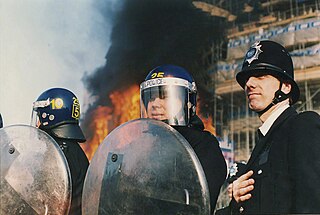
The poll tax riots were a series of riots in British towns and cities during protests against the Community Charge, introduced by the Conservative government of Prime Minister Margaret Thatcher. The largest protest occurred in central London on Saturday 31 March 1990, shortly before the tax was due to come into force in England and Wales.

Lieutenant-Colonel Sir Edmund Yeamans Walcott Henderson was an officer in the British Army who was Comptroller-General of Convicts in Western Australia from 1850 to 1863, Home Office Surveyor-General of Prisons from 1863 to 1869, and Commissioner of Police of the Metropolis, head of the London Metropolitan Police, from 1869 to 1886.

Cockspur Street is a short street in the City of Westminster, London, SW1 within which a very short part of Trafalgar Square links Charing Cross to Pall Mall/Pall Mall East at the point where that road changes name, opposite the traffic exit from Haymarket. It and all the streets mentioned are part of the A4. It has existed since at least the 16th century along a similar line.
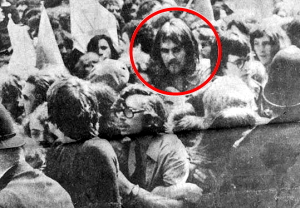
Kevin Gately was a student who died as the result of a head injury received in the Red Lion Square disorders in London while protesting against the National Front, a far-right, fascist political party. It is not known if the injury was caused deliberately or was accidental. He was not a member of any political organisation, and the march at Red Lion Square was his first. He was the first person to die in a public demonstration in Great Britain for at least 55 years.

The Battle of Lewisham took place on 13 August 1977, when 500 members of the far-right National Front (NF) attempted to march from New Cross to Lewisham in southeast London but were met by various counter-demonstrations of approximately 4,000 people that led to violent clashes between the two groups and between the anti-NF demonstrators and police. 5,000 police officers were present, and 56 officers were injured, 11 of whom were hospitalised. In total, 214 people were arrested. Later disturbances in Lewisham town centre saw the first use of police riot shields on the UK mainland.
The Reform League was established in 1865 to press for manhood suffrage and the ballot in Great Britain. It collaborated with the more moderate and middle class Reform Union and gave strong support to the abortive Reform Bill 1866 and the successful Reform Act 1867. It developed into a formidable force of agitation at the very heart of the country.
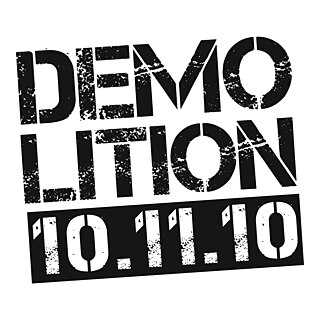
The 2010 United Kingdom student protests were a series of demonstrations in November and December 2010 that took place in several areas of the country, with the focal point of protests being in central London. Largely student-led, the protests were held in opposition to planned spending cuts to further education and an increase of the cap on tuition fees by the Conservative–Liberal Democrat coalition government following their review into higher education funding in England. Student groups said that the intended cuts to education were excessive, would damage higher education, give students higher debts, and broke campaign promises made by politicians.

The 2011 anti-cuts protest in London, also known as the March for the Alternative, was a demonstration held in central London on 26 March 2011. Organised by the Trades Union Congress (TUC), it was a protest march against planned public spending cuts by the Conservative-Liberal Democrat coalition government that was formed in May 2010.
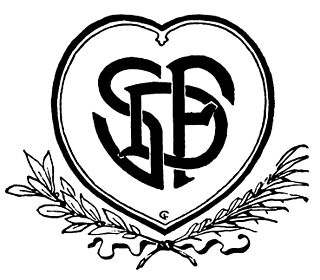
The Social Democratic Federation (SDF) was established as Britain's first organised socialist political party by H. M. Hyndman, and had its first meeting on 7 June 1881. Those joining the SDF included William Morris, George Lansbury, James Connolly and Eleanor Marx. However, Friedrich Engels, Karl Marx's long-term collaborator, refused to support Hyndman's venture. Many of its early leading members had previously been active in the Manhood Suffrage League.
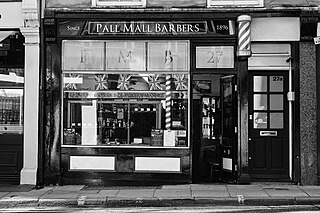
Pall Mall Barbers is a barbershop chain with six locations in London and one in New York City. The company is owned and managed by Richard Marshall.
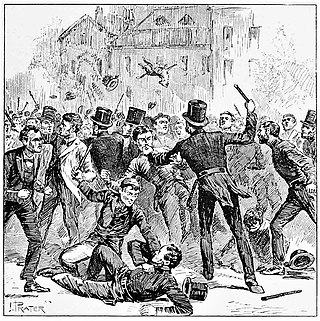
The Coldbath Fields riot took place in Clerkenwell, London, on 13 May 1833. The riot occurred as the Metropolitan Police attempted to break up a meeting of the National Union of the Working Classes (NUWC). Figures for the number of police present at the varied between 70 and 600 officers; figures for members of the public who attended varied between 300 and 6,000. Both Commissioners of Police of the Metropolis, Sir Charles Rowan and Sir Richard Mayne, were present and two British Army officers stood by to summon military reinforcements if needed. It is disputed which side started the violence, but Rowan led a number of baton charges that dispersed the crowd, and arrested the NUWC leaders. The crowd were pursued into side streets and a number were trapped in Calthorpe Street. Three police officers were stabbed and one, Constable Robert Culley, was killed. There were few serious injuries inflicted on members of the public.

















